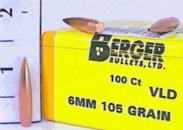New CED 'M2' Chronograph
 Reader Richard H. just tested his new CED M2 Chronograph, one of the first units in the country. This is an all-new design with many upgrades over the previous CED Millenium model. Clock speed was boosted to 48 mHz, expanding the measurable velocity range to 7,000 fps. Memory storage has been expanded 500%. You can now have up to 500 speed readings per string (and as many as 500 strings). CED claims: “Expanded digital chip design now gives the CED M2 the ability of reading velocities at much lower light levels. On clear days, this means the ability to chronograph from early morning till almost sunset.” If this claim is true, the CED M2 would definitely out-perform rival PACT and Shooting Chrony designs in marginal light conditions.
Reader Richard H. just tested his new CED M2 Chronograph, one of the first units in the country. This is an all-new design with many upgrades over the previous CED Millenium model. Clock speed was boosted to 48 mHz, expanding the measurable velocity range to 7,000 fps. Memory storage has been expanded 500%. You can now have up to 500 speed readings per string (and as many as 500 strings). CED claims: “Expanded digital chip design now gives the CED M2 the ability of reading velocities at much lower light levels. On clear days, this means the ability to chronograph from early morning till almost sunset.” If this claim is true, the CED M2 would definitely out-perform rival PACT and Shooting Chrony designs in marginal light conditions.
We’ve found that, with most chronographs, the biggest problems are confusing controls and keypad sequences that are hard to remember. CED has addressed that with the new machine. The $199.00 CED M2 Chronograph features single function string removal (something we wish the Shooting Chrony had), and the M2 offers “one touch” calculation of the average of the three highest velocities in a string. Another major (and much appreciated) improvement is the addition of a USB interface. That offers simple “plug and play” compatibility with laptops and home PCs. USB connectivity will make it much easier to download Chrono data into the updated CED Data Collector software. For more info, contact Competitive Edge Dynamics, CEDHK.com, (610) 366-9752. Right now the CED M2 is back-ordered, but a new shipment is arriving in 2 weeks and M2s should be available by mid-May at Brownells and MidwayUSA.com.

Richard tells us: “I’ve been frustrated for a long time with my inability to get my extreme spreads below 30-50 fps and have wondered if my bargain-basement Chrony F-1 might be part of the problem. Well, after I got my Denver Instruments MXX-123 last month, the powder scale was no longer a credible culprit, so I went shopping for a new chrono. This is what I found. Initial results (only three 5-shot groups so far) suggest that ES with the CED M2 is only half of what the Chrony measured. In the Chrony’s defense though, it is surprisely good for something that costs less than half as much (also more convenient and more portable).” If anyone in the Sacramento, CA area has an Oehler Chrono, Richard would like to do a 3-way comparision test with the CED, Oehler, and Shooting Chrony. We’d all be interested in the results. Contact Mailbox@6mmBR.com and we’ll put you in touch with Richard.












 Eric Stecker of Berger Bullets tells us: “We use certified gauges and indicating micrometers to measure the OD. The new die produces bullets that are .2431 to .2432 at the pressure ring and .2430 at a point half way up the bearing surface. A measurement taken on the bearing surface close to the ogive will be .2429. The taper on these bullets is straight which we believe is good as this taper may line things up nicely in the bore.
Eric Stecker of Berger Bullets tells us: “We use certified gauges and indicating micrometers to measure the OD. The new die produces bullets that are .2431 to .2432 at the pressure ring and .2430 at a point half way up the bearing surface. A measurement taken on the bearing surface close to the ogive will be .2429. The taper on these bullets is straight which we believe is good as this taper may line things up nicely in the bore.




